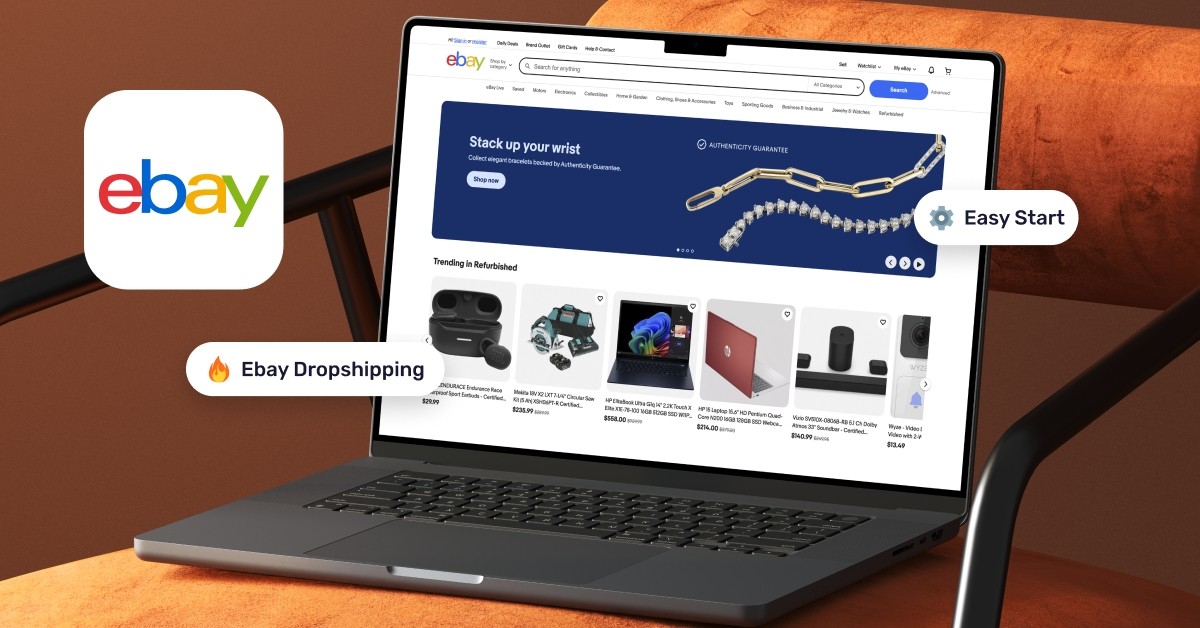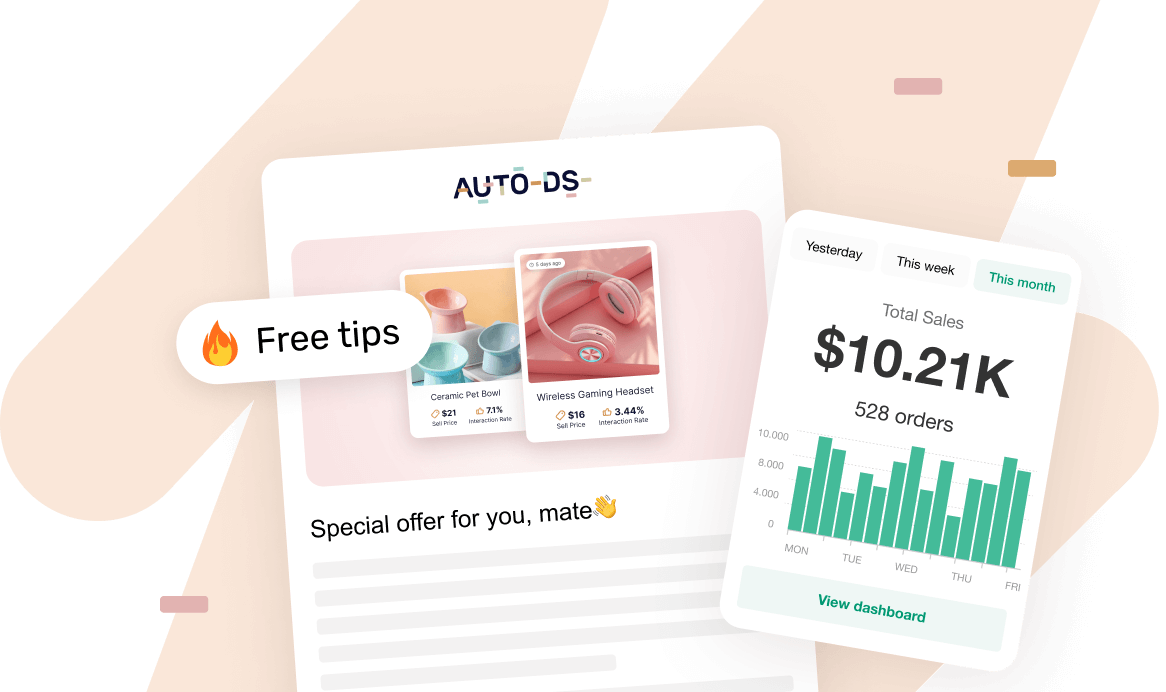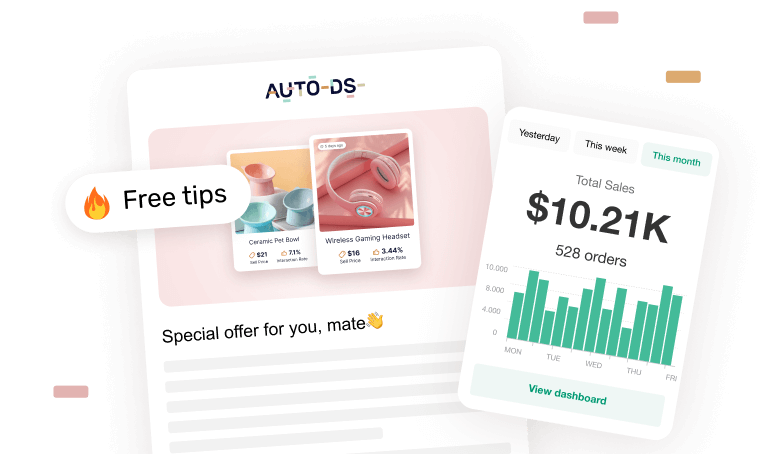If you’re thinking about jumping into online selling, eBay is one of the most underrated goldmines out there. While everyone’s busy chasing TikTok Shops and Shopify stores, eBay’s been sitting quietly with 134 million active buyers, waiting for the right products to land on their screens.
I’ve seen countless beginners launch their first e-commerce hustle on eBay and actually make consistent sales without fancy ads, complicated funnels, or huge startup costs. That’s because eBay already brings the traffic; your job is just to show up with the right products and a solid setup.
This guide will cover everything you need to know, no matter if you’re reselling stuff from around the house, launching a side hustle, or going full eBay dropshipping mode. Let’s get your eBay journey started (minus the confusion and chaos).
⚠️ Warning: eBay’s VeRO program can flag non-compliant listings, risking penalties or account suspension for dropshippers. AutoDS can protect your business with automated VeRO compliance checks. Find out more here.
Getting Started with eBay
Before you can make that first sale (and feel like a boss), there are a few setup steps to knock out. The good news? Setting up a seller account on eBay is way easier than people think. It just needs to be done right.
Create an eBay Seller Account
First things first, you need to create a seller account. You can start from scratch or upgrade an existing eBay buyer account.
eBay gives you two seller types:
- Personal account: Great for casual selling or if you’re testing the waters.
- Business account: Best if you’re serious about dropshipping or planning to sell regularly. You’ll be able to add your brand name, get better tools, and look more professional.
💡 Pro Tip: If you’re dropshipping or planning to sell across multiple eBay marketplaces, go straight to a business account. It looks more legit and unlocks extra selling features.
Then, it’s time to set up your account. You can do it like this:
- Go to eBay and click Register.
- Choose Business or Personal based on your goals.
- Enter your name (or business name), email, and a strong password.
- Verify your email and phone number.
That’s your basic setup. Now, eBay will prompt you to finish your seller setup before you can start listing items. eBay partners with third-party services (like Plaid or ID.me depending on your region) to verify who you are. You’ll need:
- A valid ID (passport, driver’s license, or national ID)
- Bank account info (for payouts: this is how you get paid!)
- A valid credit or debit card (used to pay fees if needed)
Once verified, you’re officially in seller territory.
Set Up Your Seller Profile
Before buyers trust you with their money, you need to look like a real human (or brand) behind the screen. So, choose a user-friendly name! Make it simple, clean, and memorable. Avoid usernames like crazyresellerxoxo92… Trust me, it screams unprofessional, and nobody will ever remember it.
- Good: CityHomeFinds, TrendyElectroGear, GreenGadgetCo
- Not great: flippin4life77, bargainjunkdealz
Your eBay store branding strategy is equally important. A logo, your real photo, or a clean brand icon is a must. Also, write a short seller bio that shows you care about customer service, fast shipping, or whatever makes your store stand out.
It doesn’t have to be anything long, complicated or difficult. It could look something like this:
“We specialize in trending electronics and home gadgets. Fast shipping, responsive support, and 100% customer satisfaction are our top priorities.”
Last but not least, setting your preferences early saves a ton of time later. Decide:
- Shipping: Domestic only or worldwide? Do you offer free shipping? What courier will you use?
- Returns: eBay recommends at least 30-day returns, and buyers love it. If you’re dropshipping, sync this with your supplier’s return policy.
And don’t forget: Set expectations clearly. eBay buyers HATE surprises.
What to Sell on eBay
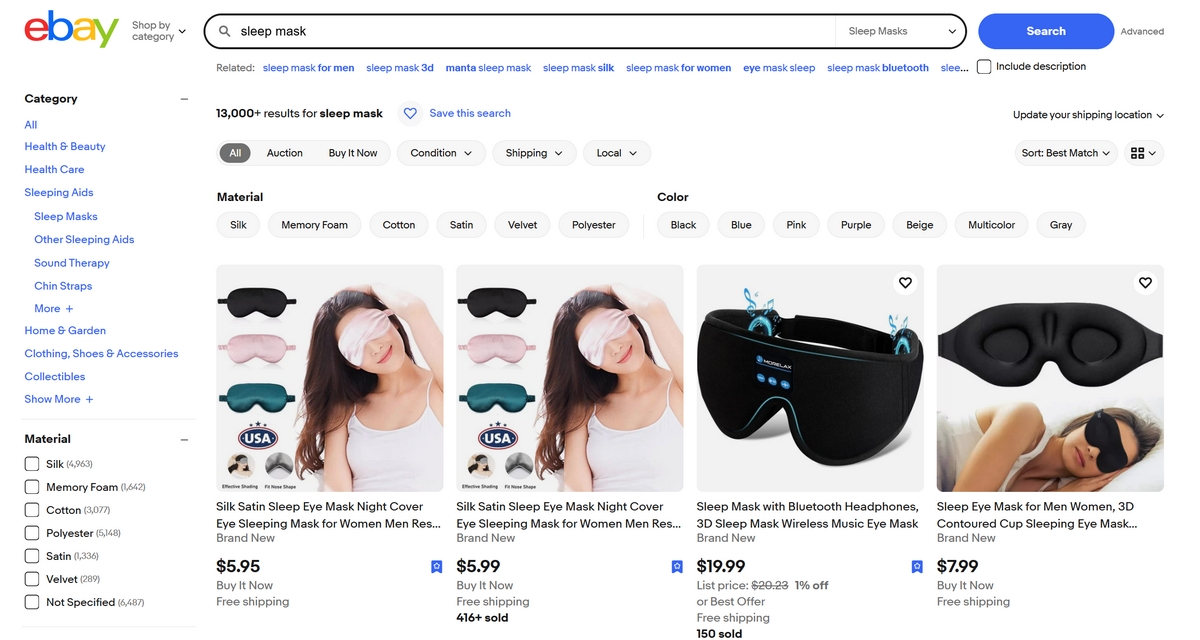
You’re all set up. Now comes the big question: what should you actually sell on eBay? This part can make or break your success. There’s room for almost everything on eBay, but not everything is profitable (and not everything is allowed).
Choosing the Right Products
eBay was originally known as a secondhand platform, but new items are dominating the game now, especially with dropshippers and brand-new sellers.
- New items = ideal for dropshipping, gift buyers, and high-volume sales
- Used items = still work great for niche audiences, collectibles, or vintage categories
So, if you’re focusing on new items, you should know the top-selling categories on eBay in 2025:
- Consumer electronics (headphones, chargers, keyboards)
- Home & garden (organizers, kitchen tools, smart lighting)
- Health & beauty (makeup tools, personal care, supplements)
- Car accessories (LED lights, organizers, wireless chargers)
I recommend using these as your starting point and niche down from there. Always remember: the more specific and oriented the niche is, the more profit potential it has.
Research Tools For eBay
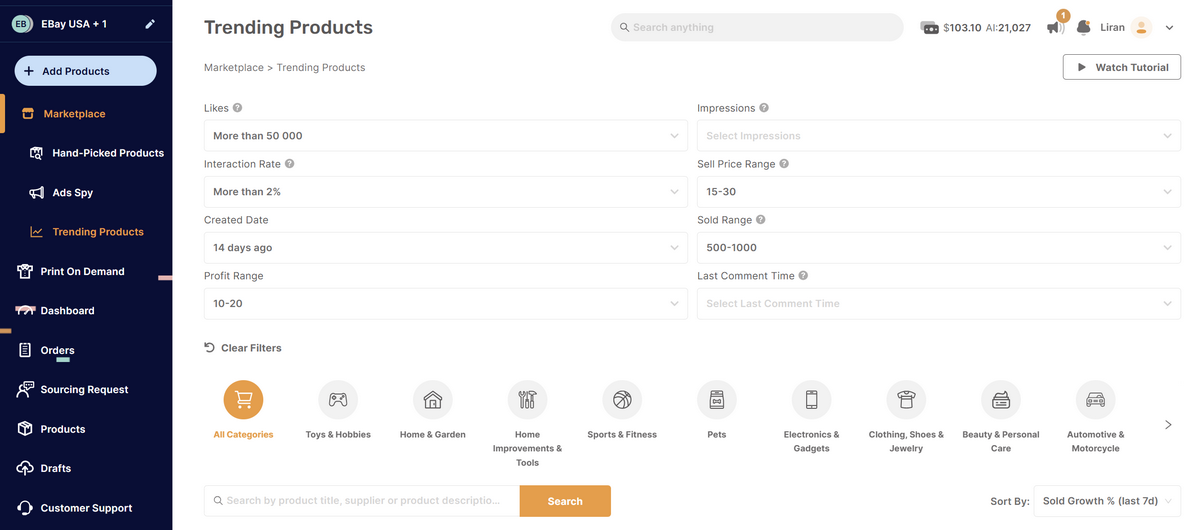
Now, smart sellers don’t guess: they research first. If you’re trying to discover something really unique and/or profitable, you can lean on these expert tools for finding the best-selling items for eBay dropshipping:
- eBay Terapeak (free for sellers): Shows product trends, price history, and sales volume
- eBay Advanced Search: Spy on what’s selling in real-time
- AutoDS Product Research Tool: Of course, ideal when we’re talking about dropshipping. It lets you track hot-selling products across multiple suppliers.
What NOT To Sell On eBay
Let’s not get your eBay account banned, shall we? eBay has a strict list of prohibited or restricted items. Avoid:
- Counterfeit items (fake brand-name anything = instant trouble)
- Alcohol, weapons, or tobacco-related products (unless you’re licensed)
- Hazardous materials
- Digital products, downloads, or services (eBay favors physical goods)
You can find the full list on eBay’s Prohibited and Restricted Items page, and always match your item with their policies before listing; especially if you’re sourcing from dropshipping suppliers.
Creating Listings That Sell
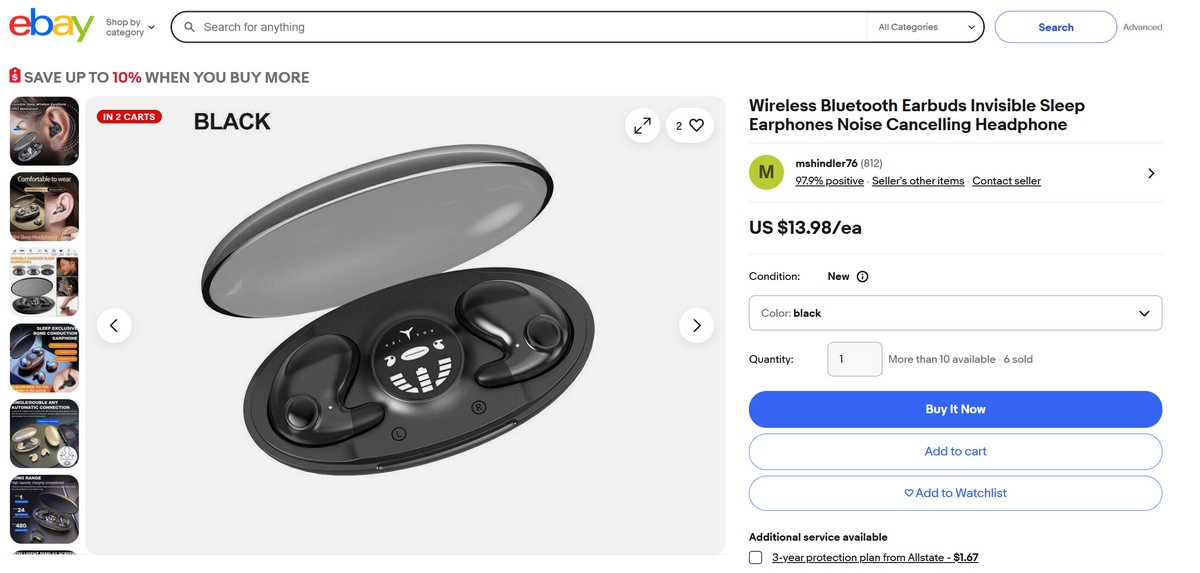
Once you’ve found the perfect product(s), it’s time to actually sell it. That’s where your eBay listing comes in.
A listing is your product’s mini storefront. It’s what people see when they’re scrolling, clicking, and deciding whether to buy or bounce. And yes, how you present your product can make or break a sale, even if you’re selling the exact same thing as 100 other people (marketing, not magic).
Think of your listing as your elevator pitch. It needs to be clear, scroll-stopping, and optimized for eBay’s algorithm.
Writing a Compelling Title
Your title is the first thing buyers see, and what helps eBay’s search engine match your listing to searches.
- Include the Right Keywords: Use relevant, high-search keywords that describe exactly what the product is. No fluff. No weird symbols. No made-up phrases. Buyers search like robots. Your title should sound more like a search query than a tweet if you want to optimize your listings for the eBay algorithm.
Example:
✅ “Wireless Bluetooth Earbuds Noise Cancelling Black – USB-C Charging”
❌ “🔥Best Bluetooth Buds Ever🔥 – OMG So Cheap!”
- Avoid Clickbait or Irrelevant Info: Trust me: adding words like “WOW” or “1000% OFF” won’t help. It might even hurt your ranking, or worse, turn off serious buyers. Keep it clean. Stick to facts. Let your photos and pricing do the flexing.
Product Descriptions and Specifications
Once the buyer clicks in, your description needs to close the deal.
- What To Include
- Product dimensions (size, weight, material)
- Key features (Bluetooth 5.3, rechargeable battery, waterproof)
- What’s included (box contents, accessories)
- Who it’s for (great for travel, kids, gamers, etc.)
- Any care instructions or warnings (especially for electronics, clothing, or kitchenware)
- Use Bullet Points and Clear Formatting: Nobody likes reading walls of text. Format your description so it’s skimmable, like this article. Example:
Features: - Noise-canceling up to 30dB
- Compatible with iOS and Android
- USB-C fast charging (cable included)
- Up to 8 hours battery life
📦 Ships in 1 business day. 30-day returns accepted.
Use emojis sparingly; they’re fun but don’t overdo it.
Interested in products like this? Here are the hot-selling Bluetooth devices for dropshipping in 2025.
Uploading High-Quality Photos
Photos are everything on eBay. They build trust, help you stand out, and honestly, most buyers decide to click based on the first image alone.
- How Many Photos Should You Include? eBay allows up to 12 images per listing, and yes, use as many as you can. Show:
- Front, back, and side views
- Zoomed-in details (texture, stitching, buttons)
- Packaging (if nice or branded)
- Size comparisons (e.g., next to a phone or hand)
- Tips for Great Product Photos
- Use natural lighting or a simple lightbox
- Neutral backgrounds work best (white or light gray)
- Avoid stock images, even if dropshipping, try to edit or brand your photos
- No filters or over-editing. Just clean, clear visuals
Pricing Your Products
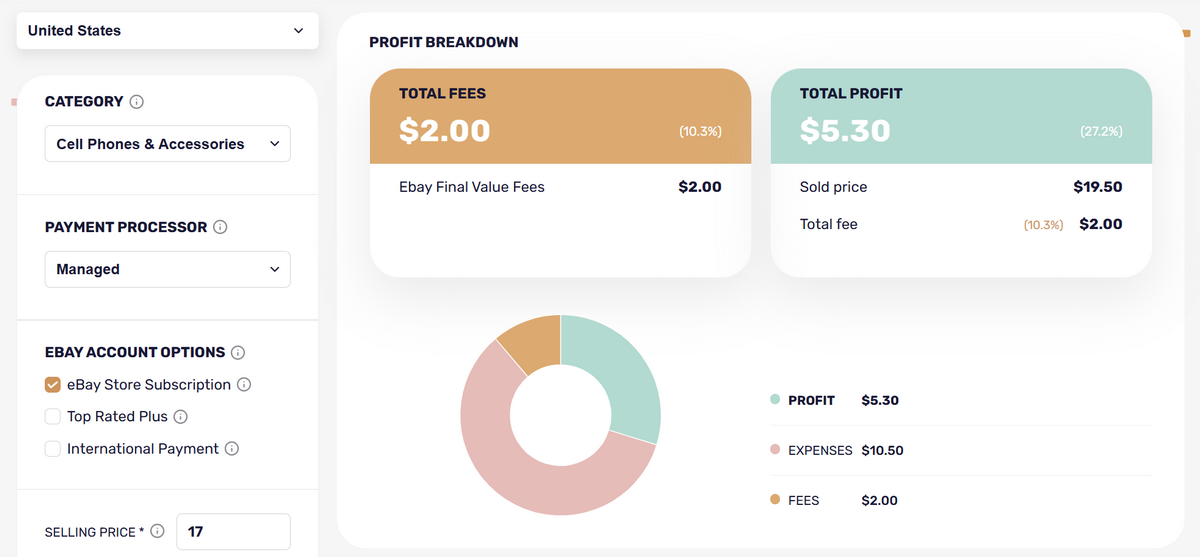
Now, let’s talk about the pricing game. It’s part science, part art, part “what the heck are my competitors doing?!”
For this matter, eBay still allows auctions, but in 2025, fixed-price listings dominate, especially for new or dropshipped items.
- Fixed Price (Buy It Now): Instant purchases. More control. Easier for dropshippers.
- Auction: Great for rare, collectible, or used items. Not ideal for high-volume selling.
So, stick with fixed-price unless you’re selling niche vintage goods or trying to gamify your listing.
Also, competitor research is another must. Check how much others are charging for similar items. Use eBay’s Advanced Search to see sold listings, not just active ones, because listed ≠ sold.
Set your price to be:
- Competitive (but not underpriced)
- Profitable (always account for fees)
- Aligned with your product quality
Last but not least, consider fees. Shipping, taxes, and platform fees can eat your profit fast if you’re not careful. Most beginners forget to factor in the following:
- eBay’s final value fee (~13.25% in most categories)
- PayPal/processing fees (if applicable)
- Shipping costs (whether free or not, someone’s paying it)
- Supplier price (including packaging)
🆕Beginner Tip: Use the AutoDS eBay Fees Calculator to figure out your break-even point and ideal profit margin. It’s free, accurate, and dropshipper-friendly.
Managing Shipping and Returns
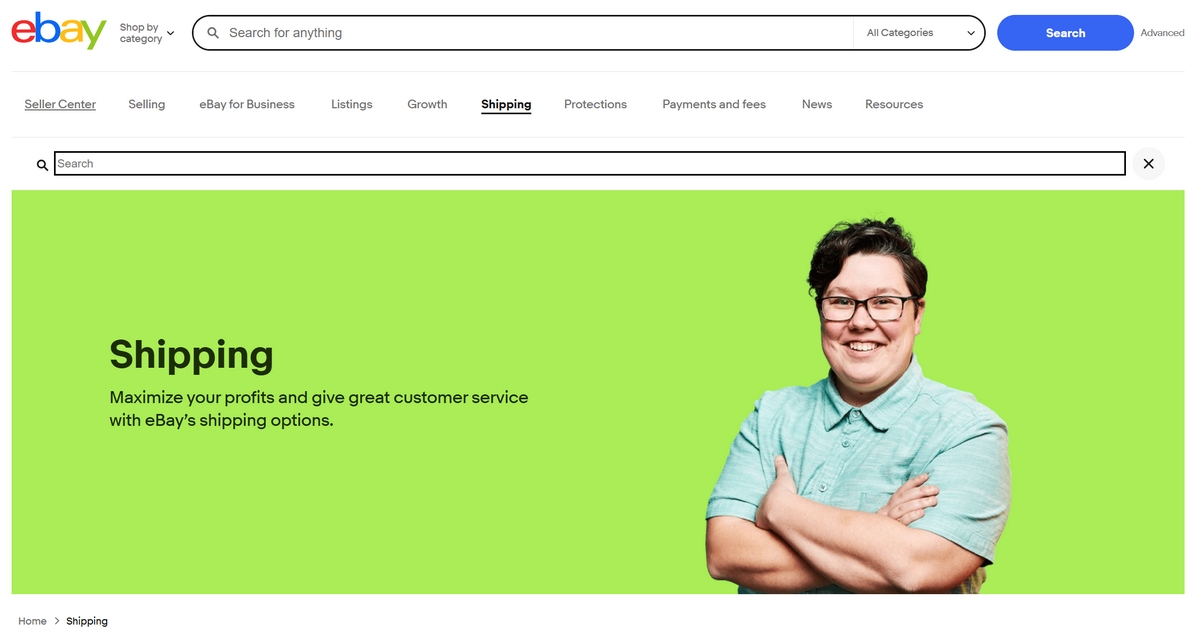
Shipping isn’t one-size-fits-all, but eBay gives you a ton of flexibility to choose what works best for your business model.
Choosing Shipping Options
If you’re just starting (or working with U.S.-based suppliers), domestic shipping is the safest bet. It’s faster, simpler, and comes with fewer surprises. You won’t have to deal with customs forms, delays, or added import taxes, and buyers love knowing their orders will arrive quickly.
That said, international shipping can open you up to a much wider audience. But it also means dealing with longer delivery times, potential fees, and more complex logistics. If you’re sourcing products from places like China, it’s smart to work with suppliers with local warehouses or fast global couriers.
Now, let’s talk pricing.
You’ll choose between calculated shipping and flat-rate shipping. With calculated shipping, eBay determines the cost for each buyer based on their location and your product’s weight and size. It’s a great option for heavy or irregular-sized products. Flat-rate shipping, on the other hand, means every customer pays the same, regardless of where they are. If you’re selling smaller or lightweight items (like most dropshippers do), flat-rate is easier to manage and often more attractive to buyers.
And yes, free shipping is still a thing in 2025. In fact, it boosts your ranking in eBay search results and increases your chances of winning the sale. Buyers are so used to it now that they expect it. The trick? Build the shipping cost into your item price. It keeps everything cleaner and reduces cart abandonment from last-minute shipping surprises.
In short, your shipping strategy should:
- Keep delivery times reasonable
- Match your supplier’s capabilities
- Be crystal clear on costs and timeframes
Trust me, the fewer surprises for the buyer, the fewer messages and refund requests you’ll have to deal with later.
Handling Returns and Customer Expectations
Returns are part of the game. Even with the best product, best listing, and fastest shipping, someone’s going to change their mind or have an issue. The key is to handle it like a pro and set expectations before problems even pop up.
The first thing you need is a clear return policy. On eBay, you’re in control of your return terms, so take a moment to decide what works for your business. I always recommend offering at least 30-day returns, because that’s the standard most buyers look for, and eBay actually boosts listings that offer them.
You can choose to offer free returns or ask the buyer to cover return shipping. Either way, make sure your policy is visible in your listings and consistent across your store. If you’re dropshipping, always double-check that your supplier allows returns and that your policy matches theirs (otherwise, you’ll be stuck covering costs out of your own pocket.)
Now, let’s talk about buyer protection. eBay’s Money Back Guarantee is designed to protect buyers if something goes wrong. If a buyer opens a dispute, eBay gives you a chance to respond, issue a refund, or send a replacement. But if things escalate and they step in, they’ll usually side with the buyer, unless your listing and communication were totally clear.
So, how do you avoid drama?
- Upload tracking info for every order
- Be super accurate in your product descriptions
- Respond to buyer messages quickly
- Stay polite (even when buyers aren’t)
Remember: buyers aren’t out to get you (most of the time 😅). They just want to feel safe spending money online. If your shipping and return setup is simple, your listings are transparent, and you treat buyers with respect, you’ll build a strong reputation, and that’s worth gold on eBay.
After the Sale: What’s Next?
You made your first sale, amazing! But now comes the part where you prove to your buyer that you’re not just another random seller on the internet. What happens after the sale is what builds your reputation and brings customers back.
Let’s walk through the essentials.
Order Fulfillment and Tracking

Whether you’re shipping the product yourself or dropshipping it through a supplier, the goal is to get it to your buyer fast and safely.
If you’re handling fulfillment yourself, ensure your packaging is clean, protective, and properly fits the product. No one wants to receive a phone case in a giant crushed box or worse, wrapped in duct tape and hope.
If you’re dropshipping, the packaging will depend on your supplier. Still, choose fast and reliable suppliers that use neutral or branded packaging.
Now, always upload a tracking number. eBay makes this easy. Once the order is shipped (either by you or your supplier), just go into your Seller Hub, find the order, and add the tracking number. AutoDS can update your tracking number automatically, streamlining the whole fulfillment process.
Buyers feel 100x more confident when they can follow their package in real time. Plus, it protects you in case anything gets delayed or lost along the way.
Providing Great Customer Service
Here’s a little secret: great customer service is what separates top-rated sellers from the rest. Even if something goes wrong (and sometimes it will), your attitude and responsiveness can save the day (and your eBay feedback score).
Start by responding to buyer messages quickly. eBay tracks how fast you reply, and it actually affects your performance rating. Aim to reply within 24 hours, even if it’s just a quick “Thanks for reaching out, I’ll look into this and get back to you shortly.”
If a buyer has an issue with the product, be professional and understanding. Offer solutions: a refund, a replacement, or even a small discount if it’s something minor. Don’t argue or ghost people; that’s how you end up with negative reviews and cases opened against you.
Encourage happy buyers to leave feedback. You can’t ask for 5-star reviews, but a friendly message like:
“Thanks again for your order! If everything arrived as expected, I’d really appreciate your feedback 😊”
…goes a long way.
And when someone does leave a glowing review? Respond! “Thanks for your kind words!” shows future buyers you care and builds your credibility.
Bottom line: you’re running a business here. Treat your buyers like customers, not transactions, and they’ll remember you.
Growing Your eBay Business
Once you’ve made a few sales and feel comfortable with the platform, it’s time to level up. Scaling your eBay business means thinking beyond individual orders and moving into systems, automation, and smarter decision-making.
You don’t need to be a massive company or quit your job to grow. But you do need to start thinking like a real seller.
And this is where using the right tools makes a huge difference. I’m not saying you can’t do it all manually. You can. But I’m telling you from experience, once I started automating repetitive tasks, my eBay store became 10x easier to manage and way more profitable.
First, let’s talk about the most powerful tool out there to grow consistently: AutoDS.
Scaling Up With AutoDS
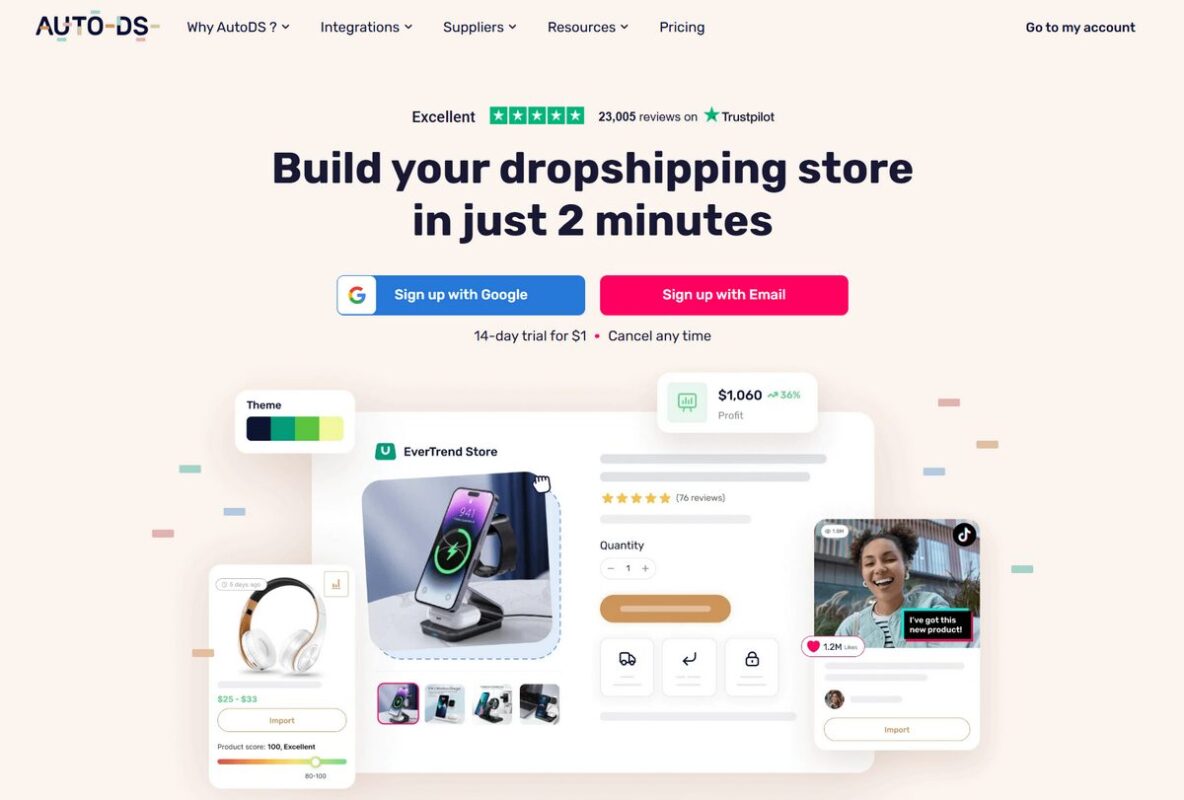
This is your game-changer if you’re serious about building a profitable eBay business. AutoDS is an all-in-one automation platform explicitly designed for dropshippers, and it works perfectly with eBay.
AutoDS provides full eBay automation tools for dropshippers, helping you eliminate the boring stuff like manual imports, price tracking, and order fulfillment. Instead of spending hours copying product info, checking for stock updates, or chasing tracking numbers, AutoDS does all of it for you in the background, reliably and efficiently.
Even better, AutoDS delivers faster and more accurate product syncing than manual workflows, so your store always reflects real-time stock and pricing. That means fewer order issues, happier customers, and a lot less stress.
And when you’re ready to grow? AutoDS helps sellers scale on eBay without hiring a team, making it possible to expand your store while still keeping things lean and manageable.
About eBay’s VeRO:
eBay’s VeRO (Verified Rights Owner) program safeguards intellectual property, but it poses a significant challenge for dropshippers. Listing a VeRO-protected item can lead to immediate listing removals, account restrictions, or even permanent bans, jeopardizing your business. AutoDS eliminates this risk by integrating a daily-updated VeRO list into its product import system. When you add an item from eBay, AutoDS automatically checks it for VeRO compliance, instantly alerting you if the product is restricted, so you can choose to skip it or proceed cautiously, keeping your store safe.
AutoDS doesn’t stop at compliance. Its powerful product research tools help you discover trending, high-margin products to boost your sales. Plus, AutoDS provides a curated list of winning products, hand-selected by e-commerce experts, giving you a competitive advantage. With AutoDS, you’re equipped to build a compliant, profitable dropshipping business with ease.
🚀 Start dropshipping smarter on eBay! Sign up for AutoDS’s 14-day trial for only $1 and experience VeRO compliance and powerful product tools firsthand.
Key AutoDS Features for eBay Sellers
- Product Research Tool: Find trending, high-converting products across multiple suppliers
- One-Click Product Importer: Add new items to your eBay store in seconds, with full descriptions and images
- Price & Stock Monitoring: AutoDS tracks your supplier’s inventory and pricing 24/7, and updates your listings instantly
- Automated Order Fulfillment: Auto-fulfill orders and upload tracking numbers without lifting a finger
- Dashboard Overview: See your store performance, profits, and orders at a glance
- AI-Powered Tools: Optimize titles, images, and descriptions using built-in AI assistants
Whether you’re just starting out or already getting consistent orders, AutoDS gives eBay sellers a reliable, stress-free way to scale. And unlike other platforms that feel clunky or incomplete, AutoDS was built with eBay in mind, so it just works.
Boosting Visibility
Once your listings are live, you want them to be seen. Here are two easy ways to get more eyeballs on your eBay products:
- Promoted Listings: eBay lets you pay a small fee to boost your products in search results. You only pay when someone clicks, so it’s a smart way to increase traffic without overspending.
- eBay SEO Tactics: Optimize your titles and descriptions with keywords buyers actually search for. Use eBay’s Advanced Search or the AutoDS Product Research tool to find terms that work. Avoid keyword stuffing — clarity wins every time.
Analyzing Performance
Knowing what’s working (and what isn’t) helps you make better decisions over time. Use eBay’s built-in tools to track your store like a pro:
- eBay Seller Hub: This is your control center. You’ll see order status, return requests, traffic data, and more, all in one place.
- Metrics and Reports: Look at impressions, click-through rates, and conversion rates to see how your listings perform. If your views are high but sales are low, your pricing or photos might need work. If views are low, focus on SEO or advertising. Use the best practices to turn eBay watchers into buyers.
Frequently Asked Questions
How much does it cost to sell on eBay?
Selling on eBay involves a few key fees: you’ll pay a listing (or insertion) fee if you go over your free monthly listings, plus a final value fee, which is a percentage of the total sale price, usually around 13.25%. eBay also charges payment processing fees through its managed payments system. AutoDS helps sellers estimate their real profit margins by offering a free eBay fee calculator.
What items sell best on eBay?
The best-selling items on eBay tend to fall into a few evergreen and trending categories like consumer electronics, car accessories, home gadgets, fashion, and health & beauty products. AutoDS helps sellers find trending and high-demand products by using real-time data from multiple suppliers.
Can I sell internationally on eBay?
Yes, eBay allows you to sell globally by setting international shipping rates manually or by using their Global Shipping Program (GSP), which handles customs, duties, and international delivery for you. You simply ship the item to a U.S. eBay hub, and they take care of the rest.
What’s better: Auction or Buy It Now?
Both listing types have their place. Auction-style listings are better for rare, collectible, or used items where bidding can drive the price up, while Buy It Now works best for new, in-demand, or standardized products, especially if you’re dropshipping.
How do I get paid after a sale?
Once you make a sale, eBay handles the transaction through its managed payments system, which collects the buyer’s payment, deducts any fees, and sends your payout directly to your bank account. The typical payout timeline is 1–3 business days after the sale, depending on your account setup.
Conclusion: How to Sell Products on eBay?
Selling on eBay in 2025 is a real opportunity to build a sustainable business, especially when you have the right tools in your corner. From setting up your seller account to optimizing listings and automating fulfillment, every step gets easier (and more profitable) when you’re working smart.
AutoDS gives eBay sellers everything they need to scale confidently, automate the boring stuff, and focus on what grows your store. Whether you’re a total beginner or ready to level up, this platform keeps you organized, competitive, and in control.
Want to keep learning? Check out these helpful reads from the AutoDS blog:
- 👉 AliExpress To eBay Dropshipping In 2025 With AutoDS Automation — A complete guide to leveraging AliExpress for your eBay dropshipping journey.
- 👉 How To Prevent eBay Time Away Mode Issues In 2026: Full Guide — Learn how to keep your store running smoothly without triggering unwanted pauses.
- 👉 Best Dropshipping Products for 2025 That Will Make You Money — Save hours of research with this full list of winning products for dropshipping.
You’ve got this. And I’m rooting for your first (and next!) eBay sale.






